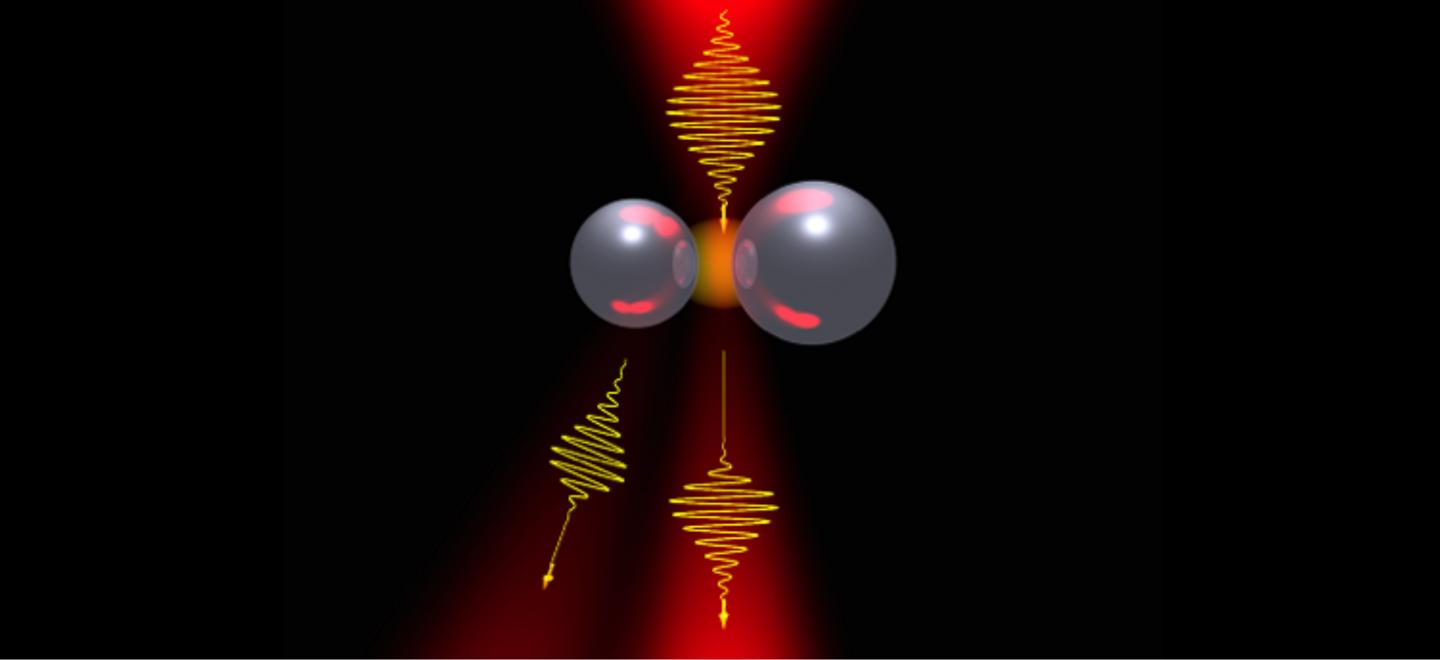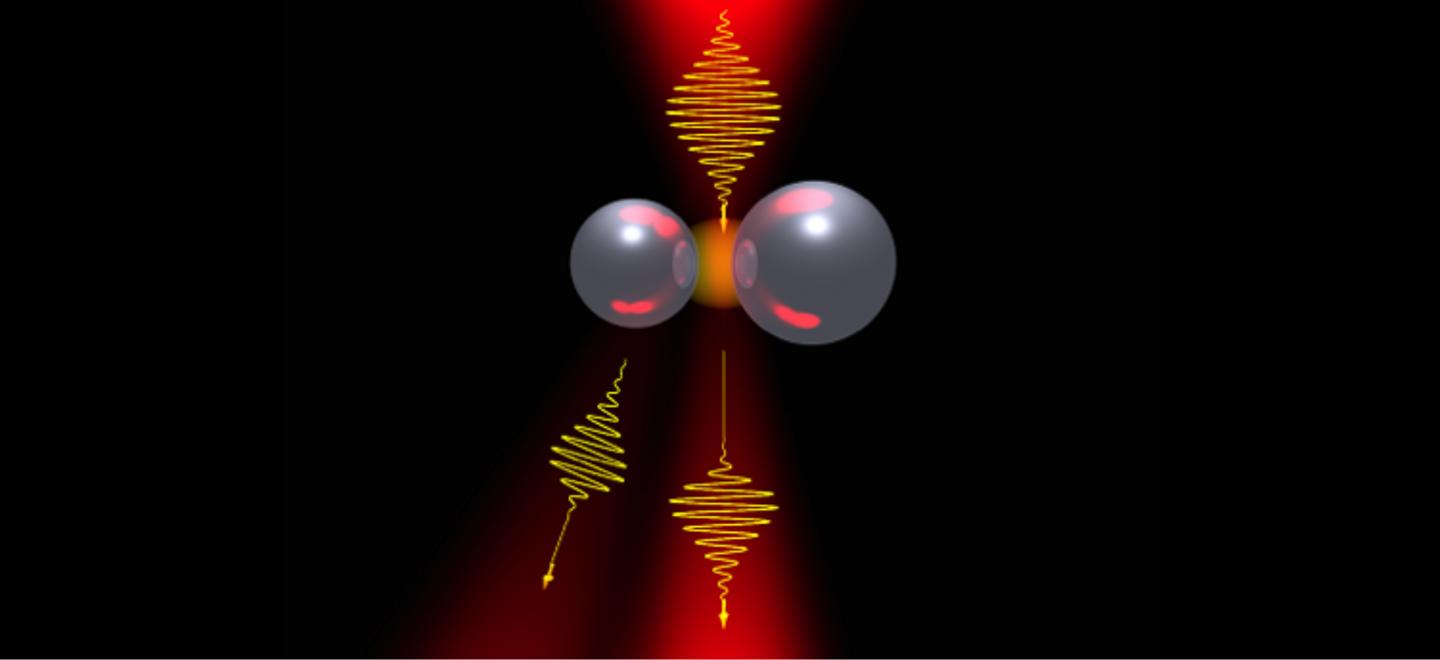
Credit: Image courtesy of the press office of MIPT
A team of physicists from ITMO University, MIPT, and The University of Texas at Austin have developed an unconventional nanoantenna that scatters light in a particular direction depending on the intensity of incident radiation. The research findings will help with the development of flexible optical information processing in telecommunication systems.
Photons–the carriers of electromagnetic radiation–have neither mass nor electric charge. This means that light is relatively hard to control, unlike, for example, electrons: their flow in electronic circuits can be controlled by applying a constant electric field. However, such devices as nanoantennas enable a certain degree of control over the propagation of electromagnetic waves.
One area that requires the "advanced" light manipulation is the development of optical computers. In these devices, the information is carried not by electrons, but by photons. Using light instead of charged particles has the potential to greatly improve the speed of transmitting and processing information. To make these computers a reality, we need specific nanoantennas with characteristics that can be manipulated in some way–by applying a constant electric or magnetic field, for instance, or by varying the intensity of incident light.
In the paper published in Laser & Photonics Reviews, the researchers designed a novel nonlinear nanoantenna that can change the direction of light scattering depending on the intensity of the incident wave (Fig. 1). At the heart of the proposed nanoantenna are silicon nanoparticles, which generate electron plasma under harsh laser radiation. The authors previously demonstrated the possibilities of using these nanoparticles for the nonlinear and ultrafast control of light. The researchers then managed to manipulate portions of light radiation scattered forward and backward. Now, by changing the intensity of incident light, they have found a way to turn a scattered light beam in the desired direction.
To rotate the radiation pattern of the nanoantenna, the authors used the mechanism of plasma excitation in silicon. The nanoantenna is a dimer–two silicon nanospheres of unequal diameters. Irradiated with a weak laser beam, this antenna scatters the light sideways due to its asymmetric shape (blue diagram in Fig. 2A). The diameters of the two nanoparticles are chosen so that one particle is resonant at the wavelength of the laser light. Irradiated with an intense laser pulse, electron plasma is generated in the resonant particle which causes changes in the optical properties of the particle. The other particle remains nonresonant, and the powerful laser field has little effect on it. Generally speaking, by accurately choosing the relative size of both particles in combination with the parameters of the incident beam (duration and intensity), it is possible to make the size of the particles virtually the same, which enables the antenna to bounce the light beam forward (red diagram in Fig. 2a).
"Existing optical nanoantennas can control light in a fairly wide range. However, this ability is usually embedded in their geometry and the materials they are made of, so it is not possible to configure these characteristics at any time," says Denis Baranov, a postgraduate student at MIPT and the lead author of the paper. "The properties of our nanoantenna, however, can be dynamically modified. When we illuminate it with a weak laser impulse, we get one result, but with a strong impulse, the outcome is completely different."
The scientists performed numerical modeling of the light scattering mechanism, Fig. 2b. The simulation showed that when the nanoantenna is illuminated with a weak laser beam, the light scatters sideways. However, if the nanoantenna is illuminated with an intense laser impulse, that leads to the generation of electron plasma within the device and the scattering pattern rotates by 20 degrees (red line). This provides an opportunity to deflect weak and strong incident impulses in different directions.
Sergey Makarov, a senior researcher at the Department of Nanophotonics and Metamaterials at ITMO University concludes: "In this study, we focused on the development of a nanoscale optical chip measuring less than 200×200×500 nanometers. This is much less than the wavelength of a photon, which carries the information. The new device will allow us to change the direction of light propagation at a much better rate compared to electronic analogues. Our device will be able to distribute a signal into two optical channels within a very short space of time, which is extremely important for modern telecommunication systems."
Today, information is transmitted via optical fibers at speeds of up to hundreds of Gbit/s. However, even modern electronic devices process these signals quite slowly: at speeds of only a few Gbit/s for a single element. The proposed nonlinear optical nanoantenna can solve this problem, as it operates at 250 Gbit/s. This paves the way for ultrafast processing of optical information. The nonlinear antenna developed by the researchers provides more opportunities to control light at nanoscale, which is what is required in order to successfully develop photonic computers and other similar devices.
###
Media Contact
Nicolas Posunko
[email protected]
@phystech
https://mipt.ru/english/
############
Story Source: Materials provided by Scienmag





